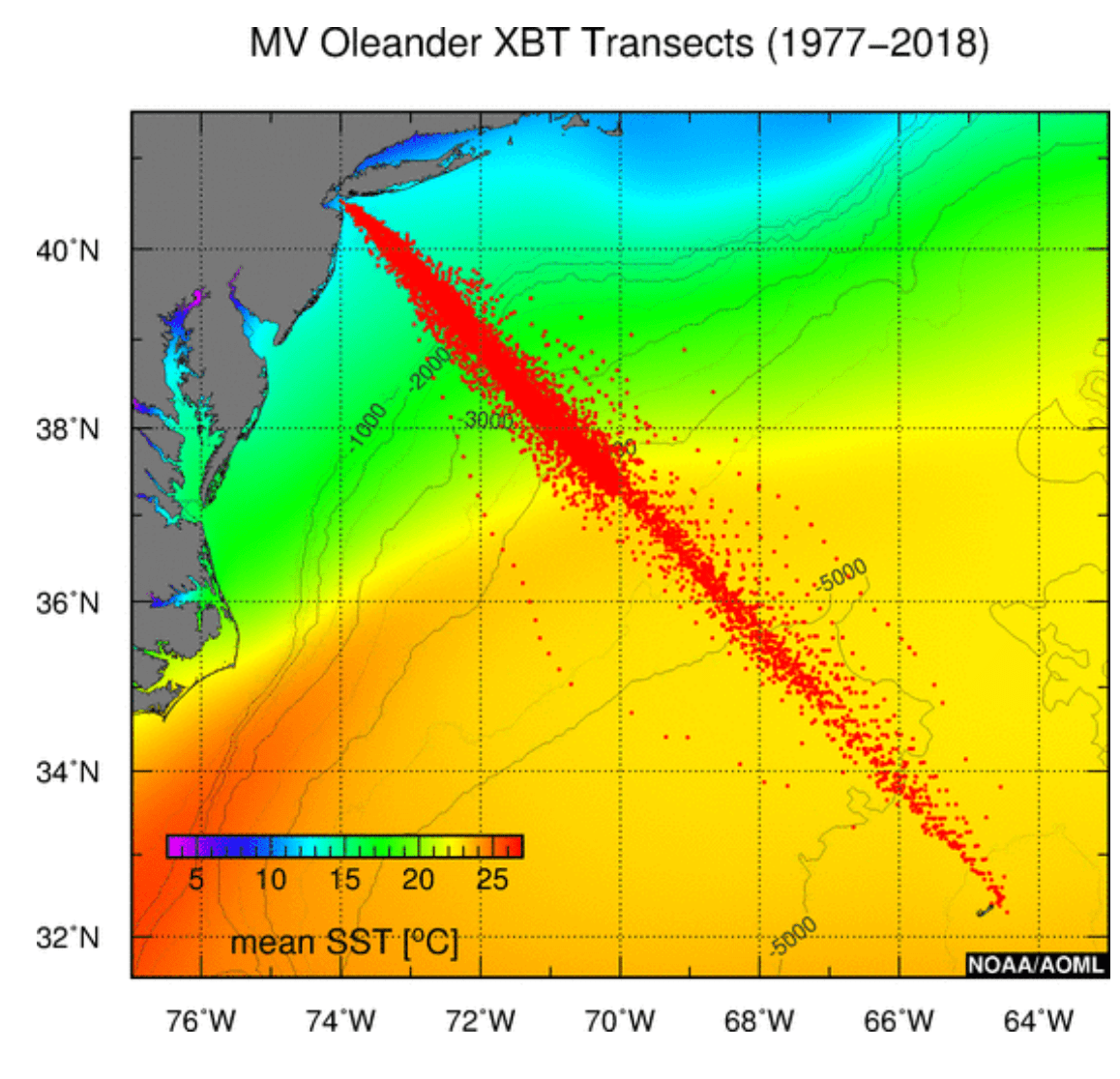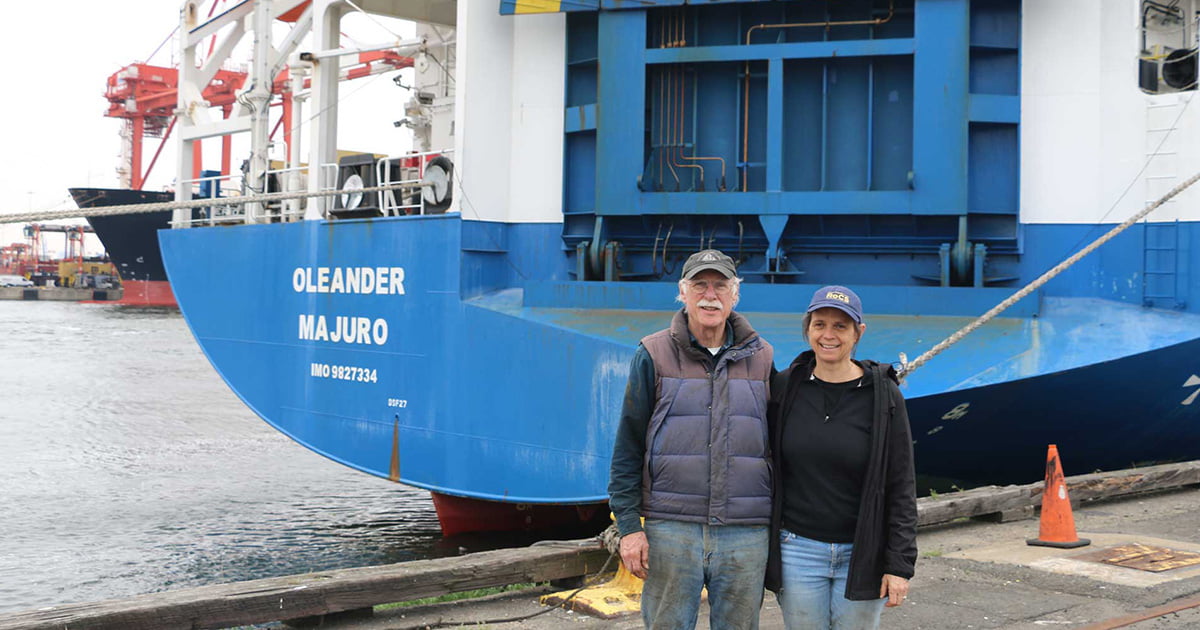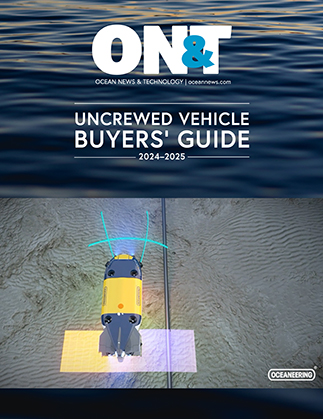Magdalena Andres, an associate scientist in WHOI’s Department of Physical Oceanography will head the effort, which began in 1992 under the leadership of H. Thomas Rossby at the University of Rhode Island Graduate School of Oceanography (URI GSO) and Charles Flagg at Stony Brook University, New York.
“The Oleander Project has provided a glimpse into the workings of a critical part of the ocean over a period of unparalleled change,” said Andres. “The entire ocean science community is indebted to Tom and Charles’s commitment to it, and we are honored to have the opportunity to see that it continues for many years to come.”
The National Science Foundation-funded Oleander Project is named after the cargo ship CMV Oleander, which is operated by Bermuda Container Line and makes weekly trips between Elizabeth, N.J., and Bermuda. Along the way, it crosses the Gulf Stream and other currents between the two ports that together, make up an important part of the Atlantic Meridional Overturning Circulation. This vast oceanic circulatory system influences climate and weather patterns across North America, Europe, and many other parts of the globe and may itself be undergoing change resulting from human impacts on the global climate and ocean system.
 Map showing the location of MV Oleander XBT deployments since 1977 (red dots), and the annual mean sea surface temperature (SST), superimposed on the regional bathymetry between New Jersey and Bermuda. Note the higher sampling frequency approximately between 70°W and 74°W, a region of high scientific interest because of its proximity to the coast of Cape Hatteras, North Carolina, where the warm core of the Gulf Stream starts to depart from the East Coast of the US. The XBTs deployed from the MV Oleander are provided by NOAA/AOML. Credit: NOAA AOML
Map showing the location of MV Oleander XBT deployments since 1977 (red dots), and the annual mean sea surface temperature (SST), superimposed on the regional bathymetry between New Jersey and Bermuda. Note the higher sampling frequency approximately between 70°W and 74°W, a region of high scientific interest because of its proximity to the coast of Cape Hatteras, North Carolina, where the warm core of the Gulf Stream starts to depart from the East Coast of the US. The XBTs deployed from the MV Oleander are provided by NOAA/AOML. Credit: NOAA AOML
The inspiration to put oceanographic sensors on the ship stemmed from Rossby’s realization that scientists on research ships alone could never hope to make the number and types of measurements needed to track changes of such a large region of the ocean playing out over time scales from days to decades. As a result, Rossby and Flagg worked with shipbuilders to incorporate an acoustic Doppler current profiler (ADCP), which measures the velocity of water deep beneath the surface, into the construction of what became the second ship named Oleander. They also worked with the National Oceanic and Atmospheric Administration (NOAA) to add an automated system designed by WHOI engineers to launch expendable bathythermographs (XBTs) that make high-resolution measurements of the upper ocean while the ship was underway.
Today, the third iteration of Oleander is similarly equipped with two ADCPs and an XBT auto-launcher, and together both ships have made more than 1,000 crossings of the Gulf Stream. Data from the project have been cited in dozens of peer-reviewed scientific publications, including a recent paper by Rossby, Kathleen Donohue and Jaime Palter at URI GSO that found the Gulf Stream has slowed somewhat over the past century, likely as a result of changing wind patterns.
At WHOI, the Oleander Project will become part of the Science RoCs (Research on Commercial Ships) initiative, which aims to equip many more commercial vessels with an even wider array of “plug-and-play” sensors to measure physical, chemical, and biological characteristics of the ocean along the world’s major shipping routes.
“Climate change is ocean change, and if we are going to come to grips with what those changes mean for us on land, we need an “all-hands” mentality,” said WHOI Deputy Director and Vice President for Science and Engineering Rick Murray. “Oleander is a shining example of what can be accomplished with this mindset and, more importantly, of how we need to think as we look for solutions to some of our most pressing environmental challenges.”

